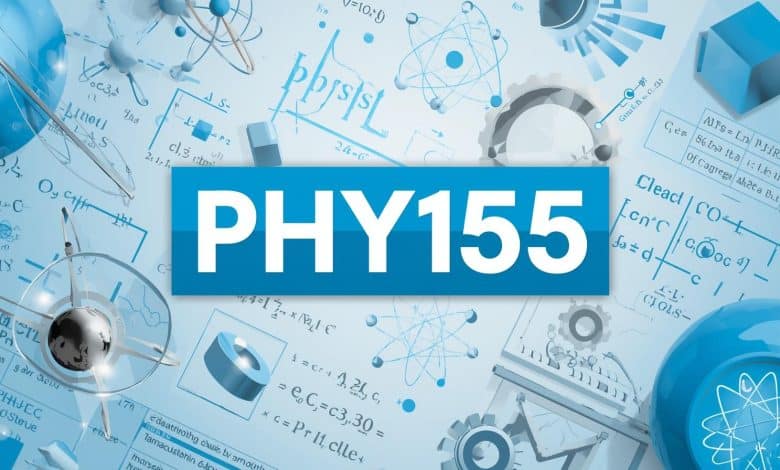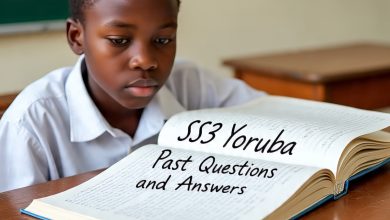PHY115 Physics Exam Questions and Answers for Effective Revision
PHY115 Physics Question Prep: Academic Session

PHY115 Physics Exam Questions and Answers for effective revision. Complete CBT guide covering mechanics, energy, momentum & oscillations.
PHY115 Physics Exam Questions and Answers
Complete CBT CA Questions for PHY115 Course
This comprehensive collection contains physics questions covering mechanics, thermodynamics, waves, and motion dynamics from the 2019/2020 academic session.
Question 1: Fluid Dynamics and Bernoulli’s Principle
Question: A wind blowing in a small room and parlor, the wind blow out the cotton but does not remove the asbestos. This illustration obeys which principle?
Options:
- A. Archimedes principle
- B. Law of floatation
- C. Bernoulli’s equation
- D. De novo principle
Answer: C
Read Also: SS1 Mathematics Exam Questions & Answers- First Term
Question 2: Projectile Motion – Time to Maximum Height
Question: A body with initial velocity 135m/s was projected at an angle 45°. What is the time taken to reach the maximum height?
Options:
- A. 7.8s
- B. 9.74s
- C. 9.81s
- D. 6.78s
Answer: B
Question 3: Equation of Continuity
Question: Which of the following represents the equation of continuity?
Options:
- A. A₁/V₁ = A₂/V₂
- B. A₁V₁ = A₂V₂
- C. A₁V₂ = A₂V₁
- D. A₁/V₂ = A₂/V₁
Answer: B
Question 4: Contact Angle in Surface Tension
Question: Contact angle for a fluid rising in a tube is:
Options:
- A. 0 degree
- B. Acute
- C. Obtuse
- D. 90 degrees
Answer: B
Question 5: Units of Impulse
Question: Which of these cannot be a unit of impulse?
Options:
- A. Js/m
- B. Nm⁻¹
- C. Ns
- D. kgms⁻¹
Answer: B
Question 6: Inelastic Collision – Kinetic Energy Transfer
Question: If a body of mass 12.2kg with initial speed 15.0m/s collides with another body of mass 2.2kg with initial speed 28.4 m/s moving in the same direction. Find the kinetic energy that is transferred in the collision if the collision is inelastic.
Options:
- A. 180J
- B. 169J
- C. 167J
- D. 160J
Answer: C
Question 7: Simple Pendulum Energy Analysis
Question: For a pendulum at equilibrium at Q and maximum displacement at P & R. Which of these is not true?
Options:
- A. No potential energy at Q
- B. Maximum P.E at P and R
- C. Maximum P.E at Q
- D. Maximum K.E at Q
Answer: C
Question 8: Flow Rate Formula
Question: The formula for flow rate is what if the cross sectional area is A and the average speed is V?
Options:
- A. J = A/V
- B. J = AV
- C. J = AV²
- D. J = A²/V
Answer: A
Question 9: Linear Momentum Ratio
Question: If two masses, 1g and 4g, have the same Kinetic energy. Calculate the ratio of the linear momentum of the two masses.
Options:
- A. 1:16
- B. 1:4
- C. 1:2
- D. 1:8
Answer: D
Question 10: Angular Position Definition
Question: Angular position is the:
Options:
- A. angle of reference relative to a dynamic direction
- B. angle of reference relative to a direction
- C. angle of reference relative to a fixed direction
- D. All the options are correct
Answer: D
Question 11: Position Change Terminology
Question: A particle undergoes a change in position from P₁ to P₂. This is called:
Options:
- A. Angular displacement
- B. Angular acceleration
- C. Distance
- D. Velocity
Answer: A
Question 12: Radius of Gyration
Question: If the inertia of a body is given as I = (Ma²/2), what is the radius of gyration?
Options:
- A. (a²/2)^(1/2)
- B. a²/2
- C. a/2
- D. a/4
Answer: A
Question 13: Elastic Collision Properties
Question: Which of these is true for two objects undergoing elastic collision?
I. KE₍ᵢ₎ = KE₍f₎ II. Total momentum is conserved in an elastic collision III. The two objects bounce off and move with different velocities
Options:
- A. I & II
- B. I & III
- C. II & III
- D. All of the above
Answer: D
Question 14: Stress and Its Effects
Question: Stress leads to/causes:
Options:
- A. Strain and deformation
- B. Strain and Reformation
- C. Strain and compression
- D. Strain and extension
Answer: A
Question 15: Purpose of Dimensional Analysis
Question: Dimensions help to:
Options:
- A. Reform equation
- B. Derive equation
- C. All of the above
- D. None of the above
Answer: C
Question 16: Maximum Height Formula in Projectile Motion
Question: The formula for maximum height is:
Options:
- A. 2u sin α/g
- B. u² sin² α/g
- C. 2u sin α/g
- D. u² sin² α/2g
Answer: D
Question 17: Unit Conversion – Revolutions to Degrees
Question: Convert 0.25 rev to degrees:
Options:
- A. 13.25°
- B. 14.33°
- C. 12.47°
- D. 11.23°
Answer: B
Question 18: Simple Pendulum Period Change
Question: The period of a string is 2s. If the length of the string is doubled, what is the new period?
Options:
- A. 1.41s
- B. 2.83s
- C. 2.00s
- D. 4.00s
Answer: B
Question 19: Shear Strain Definition
Question: Shear strain is:
Options:
- A. tan α
- B. sin cos α
- C. cos & sin α
- D. cos α
Answer: A
Question 20: Inelastic Collision Characteristics
Question: Which of the following is correct about inelastic collision?
I. KE before collision is equal to KE after collision II. Objects move with a common velocity III. Momentum is conserved IV. Objects move at different velocities
Options:
- A. I and II
- B. I and III
- C. IV and III
- D. II and III
Answer: D
Question 21: Vector Acceleration Calculation
Question: Find the acceleration of a body with initial velocity, u = -3.2i + 6.0j and it increased to a final velocity, v = 2.9i – 4.1j within 5s
Options:
- A. 0.68
- B. 0.94
- C. 2.36
- D. 2.56
Answer: C
Question 22: Potential Energy and Force Relationship
Question: What is the potential energy at point r if the force is f = -k/r²?
Options:
- A. k/r
- B. -k/r
- C. k/r²
- D. -k/r²
Answer: B
Question 23: Circular Motion Frequency
Question: A body moves in a circular motion with velocity of 0.88m/s and a radius of 0.02m. Calculate the frequency.
Options:
- A. 44Hz
- B. 7Hz
- C. 5Hz
- D. 22Hz
Answer: B
Question 24: Linear Acceleration
Question: A body changed velocity from 15m/s to 45m/s in 5s. Calculate the acceleration.
Options:
- A. 15m/s²
- B. 45m/s²
- C. 6m/s²
- D. 5m/s²
Answer: C
Question 25: Work and Efficiency
Question: A person lifted a mass of 20N through a height of 10m. Efficiency is 40%. Calculate work lost to friction.
Options:
- A. 200J
- B. 120J
- C. 80J
- D. 280J
Answer: B
Question 26: Maximum Potential Energy
Question: A body of mass 50g is dropped from the top of ceiling to reach the ground within a second. Calculate the maximum potential energy of the body at the floor.
Options:
- A. 0J
- B. 256J
- C. 28J
- D. 15J
Answer: A
Question 27: Bernoulli’s Equation Identification
Question: P₁ + (ρv²)/2 + ρgh = P₂ + (ρv²)/2 + ρgh
Identify the equation above:
Options:
- A. Poiseuille’s
- B. Bernoulli’s
- C. Torricelli
- D. Continuity
Answer: B
Question 28: Natural Forces
Question: Which of the following is not a natural force?
Options:
- A. Radioactive force
- B. Force between the nucleus and electron
- C. Centripetal and Centrifugal force
- D. I can’t remember
Answer: C
Question 29: Dimensional Analysis – MLT
Question: Which of these has the dimension MLT?
Options:
- A. Work
- B. Pressure
- C. Power
- D. None
Answer: D
Question 30: Work Done Against Friction
Question: A force of 25N drags an object through a distance of 10m with a frictional force of 7N. Calculate resultant work done.
Options:
- A. 180J
- B. 250J
- C. 70J
- D. 36J
Answer: A
Question 31: Coefficient of Friction
Question: Calculate the coefficient of friction, force is 140N and mass is 60kg.
Options:
- A. 0.24
- B. 0.14
- C. 0.30
- D. 0.36
Answer: A
Question 32: Spring Constant for Oscillating Mass
Question: A mass of 50g is made to swing with a period of 1.7 seconds, calculate the force constant.
Options:
- A. 0.88N/m
- B. 0.68N/m
- C. 0.56N/m
- D. 0.78N/m
Answer: B
Question 33: Time to Reach Given Velocity
Question: What is the time taken for an object starting from rest to attain a velocity of 60m/s if the acceleration is 14m/s²?
Options:
- A. 3.29s
- B. 4.26s
- C. 4.29s
- D. 3.33s
Answer: C
Question 34: Wire Tension and Length Relationship
Question: A tension of a wire of length 0.6m is 1.5N. Calculate the tension of a wire of length 0.4m.
Options:
- A. 3.38N
- B. 4.38N
- C. 2.36N
- D. 1.38N
Answer: A
Question 35: Derived Units
Question: Which of the following is not a derived unit?
Options:
- A. Steradian
- B. Radian
- C. Ampere
- D. Tesla
Answer: C
Question 36: Centrifugal Force
Question: The force acting on a body in a circular motion attracting opposite the center of rotation:
Options:
- A. Centripetal
- B. Centrifugal
- C. Tension
- D. Gravitation
Answer: B
Question 37: Surface Tension Force
Question: A square of side L is floating on the surface tension T. The force required to pull out the frame from the liquid:
Options:
- A. 8TL
- B. 4TL
- C. 6TL
- D. 2TL
Answer: A
Question 38: Conservation of Momentum in Split Mass
Question: A mass of 25kg moving with 12m/s split into two masses m₁ = 20kg and m₂ = 5kg. If m₁ moves with a velocity v₁ = 10m/s, find the velocity at which m₂ moves.
Options:
- A. 20m/s
- B. 15m/s
- C. 12m/s
- D. 10m/s
Answer: A
Question 39: Projectile Time of Flight
Question: A projectile is launched with speed V₀ at an angle α. What is the expression for the time of flight?
Options:
- A. T = 2V₀ sin α/g
- B. T = V₀² sin α/2g
- C. V₀² sin α/g
- D. V₀ sin 2α/g
Answer: A
Question 40: Simple Harmonic Motion – Maximum Velocity
Question: A body of mass 50g oscillates with an amplitude of 12cm and angular velocity of ω = 3.986 rad/s. Calculate the value when V is maximum.
Options:
- A. 0.48m/s
- B. 0.12m/s
- C. 0.38m/s
- D. 0.26m/s
Answer: A
Question 41: Kinetic Energy of Thrown Mass
Question: A mass 0.02kg on top of a cliff 40m high is thrown to reach the horizontal. What is the K.E?
Options:
- A. 7.74J
- B. 7.84J
- C. 7.66J
- D. 7.60J
Answer: B
Question 42: Collision Properties – Incorrect Statement
Question: Which of the following is not correct about collision?
Options:
- A. For inelastic collision K.E₍ᵢ₎ = K.E₍f₎
- B. For elastic collision K.E₍ᵢ₎ = K.E₍f₎
- C. For elastic collision, the momentum is conserved
- D. For inelastic collision, the momentum is conserved
Answer: A
Question 43: Elastic Collision Conservation Laws
Question: What happens in elastic collision?
I. Momentum is conserved II. Kinetic energy is conserved III. Momentum is increased IV. Kinetic energy is increased
Options:
- A. I & II
- B. I & III
- C. I, II & IV
- D. All of the above
Answer: A
Question 44: Unit of Pressure
Question: The unit of pressure is:
Options:
- A. kgms²
- B. Nm
- C. Ns
- D. N/m²
Answer: D
Question 45: Oscillatory Motion Types
Question: Which of the following types of motion are oscillatory?
(i) A diving board when used by a diver (ii) The motion of the balance wheel of a wrist watch (iii) The motion of the turn-table of a record player (iv) The motion of the centre of a ten kobo piece as it rolls down an inclined plane (v) The motion of the needle of a D.C ammeter into which a low A.C current is passed
Options:
- A. I and II
- B. I, II and III
- C. II, III and IV
- D. I, II and V
Answer: D
Question 46: Young’s Modulus Relationship
Question: Relationship between Young modulus, stress and strain is given by:
Options:
- A. Strain = Stress/Young modulus
- B. Strain = Young modulus × stress
- C. Strain = Young modulus/stress
- D. Stress = Strain/Young modulus
Answer: A
Question 47: Buoyancy and Upthrust
Question: A heavy object is suspended from a string and lowered into water so that it is completely submerged. The object appears lighter because:
Options:
- A. The density of water is less than that of the object
- B. The pressure is low just below the water surface
- C. The tension in the string neutralizes part of the weight
- D. It experiences an upthrust
Answer: A
Question 48: Pressure Calculation
Question: An 80kg steel cylinder with a height of 2.0m has an area of 25cm². What is the pressure exerted by the cylinder on the floor? (take g = 9.81m/s²)
Options:
- A. 3.1 × 10⁵ Pa
- B. 3.2 × 10⁻⁵ Pa
- C. 3.1 × 10⁴ Pa
- D. 3.2 × 10⁻⁴ Pa
Answer: A
Question 49: Energy Expression with Mass and Velocity
Question: If the energy E of a body depends on its mass M and velocity V, where K = constant. Which of the following expressions is correct?
Options:
- A. E = KMV²
- B. E = KMV⁻²
- C. E = KMV³
- D. E = KMV⁻³
Answer: A
Question 50: Simple Harmonic Motion Acceleration
Question: A 50g mass vibrates in SHM at the end of a spring. The amplitude of motion is 12cm and the period is 1.7s. Find the acceleration when x = 6cm?
Options:
- A. 0.82m/s²
- B. 0.53m/s²
- C. 1.42m/s²
- D. 1.36m/s²
Answer: A
Question 51: Pendulum Angular Displacement
Question: Calculate the angle of oscillation of a pendulum if length of arc is 10cm and radius is 80cm.
Options:
- A. 0.13°
- B. 7.2°
- C. 8.12°
- D. 6.25°
Answer: B
Question 52: Angular Acceleration
Question: A body of radius 30cm moved with velocity of 15m/s during 8s, what is the angular acceleration?
Options:
- A. 1.88 rad/s²
- B. 6.25 rad/s²
- C. 2.36 rad/s²
- D. 7.36 rad/s²
Answer: B
Question 53: Work Done Calculation
Question: If a body of mass 12.5g with initial velocity 10m/s and final velocity of 22.2m/s. Calculate the work done.
Options:
- A. 2.46J
- B. 3.45J
- C. 1.45J
- D. 2.67J
Answer: A
Question 54: Energy Loss in Inelastic Collision
Question: A mass of 15.2kg has a velocity of 12m/s and collides with a mass of 12.2kg and velocity of 20m/s. If they move in the same direction and the collision is inelastic. Calculate the energy lost as heat or sound.
Options:
- A. 217J
- B. 225J
- C. 210J
- D. 180J
Answer: A
Question 55: Rotational Motion from Rest
Question: A body undergoing rotational motion from rest has an acceleration of 3.18 rad/s² in 8s. Calculate the revolution in rad?
Options:
- A. 101.76
- B. 203.52
- C. 50.88
- D. 25.44
Answer: A
Question 56: Spring Constant Calculation
Question: A body of mass 400g was extended by length of 35cm. Calculate the Spring Constant (Take g = 9.8m/s²)
Options:
- A. 11.2N/m
- B. 10.7N/m
- C. 5.6N/m
- D. 8.8N/m
Answer: A
Question 57: Moment of Inertia vs Mass
Question: Which of the following is correct about moment of inertia and mass?
I. Moment of inertia is for a rotational rigid body while mass… II. Unit of inertia is kgm² while mass is kg III. Inertia is constant while mass varies
Options:
- A. All are correct
- B. I and II
- C. I and III
Answer: B
Question 58: Pendulum Period Formula
Question: For the period of pendulum bob given by T = mˣ lʸ gᶻ. Find the values of x, y, and z
Options:
- A. 0, ½, -½
- B. ½, 0, ½
- C. 0, 0, ½
- D. ½, -½, ½
Answer: A
Question 59: Maximum Height in Projectile Motion
Question: A body thrown with an initial velocity 135m/s at an angle of 45°. Calculate the maximum height attained.
Options:
- A. 464.9m
- B. 135.6m
- C. 67.5m
- D. 270m
Answer: A
Question 60: Tangential Velocity of Rotating Fan
Question: A fan rotates at an angular frequency of 900rpm. If the distance from the center to the end of the arm of a blade is 20cm. Calculate its tangential velocity.
Options:
- A. 18.85m/s
- B. 171.89m/s
- C. 180.00m/s
- D. 30.00m/s
Answer: A
Question 61: Apparent Mass in Water
Question: A cube has a length of 2cm and its density is 6600g/cm³. What is the apparent mass when submerged in water? (Density of water = 1000g/cm³)
Options:
- A. 8kg
- B. 13.2kg
- C. 4kg
- D. 6.6kg
Answer: A
Question 62: Unit of Energy
Question: What is the unit of energy?
Options:
- A. Metre
- B. Joules
- C. Kilogram
- D. Watt
Answer: B
Question 63: Definition of Moment of Inertia
Question: What is the definition of moment of inertia?
Options:
- A. The sum of the product of each of the particles and the square of the perpendicular distance to the axis of rotation
- B. The product of mass of a body and its acceleration
- C. The product of mass of a body and its velocity
- D. The work done by a body per unit time
Answer: A
Question 64: Total Kinetic Energy of Bicycle Wheel
Question: A bicycle wheel has a diameter of 0.05m, a mass of 0.80kg and a moment of inertia about its axle of 4.0 × 10⁻² kg/m². Determine the total kinetic energy of the wheel.
Options:
- A. 87J
- B. 78J
- C. 39J
- D. 48J
Answer: A
Question 65: Time to Climb Height with Given Power
Question: How long will it take a 60kg man to climb a height of 22m if he has expended energy at the rate of 0.25kW?
Options:
- A. 5.3s
- B. 34.5s
- C. 41.6s
- D. 52.8s
Answer: D
Question 66: Velocity Change Over Time
Question: The velocity of the motion of a given particle is represented by equation: V = 10cm/s + (2cm/s³)t². Find the change in the velocity of the particle in the time interval of t₁ = 2s and t₂ = 5s
Options:
- A. 54cm/s
- B. 40cm/s
- C. 24cm/s
- D. 42cm/s
Answer: D
Additional Physics Concepts Covered
Friction and Motion
- Static vs kinetic friction coefficients
- Forces at terminal velocity
- Gravitational pull and viscous drag
Center of Mass
- Properties of center of mass
- External forces acting on systems
Fluid Mechanics
- Types of flow (compressible vs non-compressible)
- Flow characteristics and properties
Work and Energy Problems
- Work done at angles
- Elastic potential energy calculations
Summary
This comprehensive collection covers fundamental physics concepts including:
- Mechanics: Projectile motion, circular motion, oscillations
- Thermodynamics: Pressure, density, fluid dynamics
- Waves and Vibrations: Simple harmonic motion, pendulums
- Energy: Kinetic energy, potential energy, work-energy theorem
- Momentum: Conservation laws, collisions (elastic and inelastic)
- Rotational Motion: Angular velocity, moment of inertia
- Materials Science: Stress, strain, elastic properties
These questions are designed to test understanding of fundamental physics principles and their applications in real-world scenarios. Each question includes detailed options and verified answers for comprehensive learning.
This collection aligns with international physics education standards as established by institutions like Cambridge University Press, ensuring students receive globally recognized preparation quality.
External Reference/Source Links
1. MIT Physics General Exam Preparation
Source: https://physrefs.mit.edu/general-exam-preparation/
MIT’s official physics exam prep guide with study strategies and sample problems.
2. MIT OpenCourseWare Physics Exams
Source: https://ocw.mit.edu/courses/8-01l-physics-i-classical-mechanics-fall-2005/pages/exams/
Collection of 12 physics practice exams with solutions and formula sheets.
3. Cambridge University Press Physics Resources
Source: https://www.cambridge.org/us/education/subject/science/physics/
Professional physics education resources and exam preparation strategies.
Disclaimer
This collection of PHY115 physics questions and answers is provided exclusively for educational, preparation, and revision purposes.
The content is intended to help students prepare effectively for their physics examinations.
Note: This material supplements but does not replace official course textbooks, lectures, or instructor-provided resources. Students are encouraged to use this as one component of a comprehensive study strategy.




